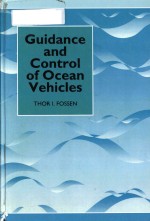图书介绍
Guidance and control of ocean vehiclesPDF|Epub|txt|kindle电子书版本下载

- Thor I. Fossen 著
- 出版社: Wiley
- ISBN:0471941131
- 出版时间:1994
- 标注页数:480页
- 文件大小:149MB
- 文件页数:493页
- 主题词:
PDF下载
下载说明
Guidance and control of ocean vehiclesPDF格式电子书版下载
下载的文件为RAR压缩包。需要使用解压软件进行解压得到PDF格式图书。建议使用BT下载工具Free Download Manager进行下载,简称FDM(免费,没有广告,支持多平台)。本站资源全部打包为BT种子。所以需要使用专业的BT下载软件进行下载。如BitComet qBittorrent uTorrent等BT下载工具。迅雷目前由于本站不是热门资源。不推荐使用!后期资源热门了。安装了迅雷也可以迅雷进行下载!
(文件页数 要大于 标注页数,上中下等多册电子书除外)
注意:本站所有压缩包均有解压码: 点击下载压缩包解压工具
图书目录
1 Introduction1
2 Modeling of Marine Vehicles5
2.1 Kinematics6
2.1.1 Euler Angles7
2.1.2 Euler Parameters12
2.1.3 Euler-Rodrigues Parameters17
2.1.4 Comments on Parameter Alternatives17
2.2 Newtonian and Lagrangian Mechanics18
2.2.1 Newton-Euler Formulation18
2.2.2 Lagrangian Formulation19
2.2.3 Kirchhoff’s Equations of Motion20
2.3 Rigid-Body Dynamics21
2.3.1 6 DOF Rigid-Body Equations of Motion25
2.4 Hydrodynamic Forces and Moments30
2.4.1 Added Mass and Inertia32
2.4.2 Hydrodynamic Damping42
2.4.3 Restoring Forces and Moments46
2.5 Equations of Motion48
2.5.1 Vector Representations48
2.5.2 Useful Properties of the Nonlinear Equations of Motion49
2.5.3 The Lagrangian Versus the Newtonian Approach52
2.6 Conclusions54
2.7 Exercises55
3 Environmental Disturbances57
3.1 The Principle of Superposition57
3.2 Wind-Generated Waves60
3.2.1 Standard Wave Spectra62
3.2.2 Linear Approximations to the Wave Spectra69
3.2.3 Frequency of Encounter72
3.2.4 Wave-Induced Forces and Moments73
3.3 Wind76
3.3.1 Standard Wind Spectra76
3.3.2 Wind Forces and Moments77
3.4 Ocean Currents84
3.4.1 Current Velocity84
3.4.2 Current-Induced Forces and Moments85
3.5 Conclusions90
3.6 Exercises91
4 Stability and Control of Underwater Vehicles93
4.1 ROV Equations of Motion94
4.1.1 Thruster Model94
4.1.2 Nonlinear ROV Equations of Motion99
4.1.3 Linear ROV Equations of Motion99
4.2 Stability of Underwater Vehicles102
4.2.1 Open-Loop Stability102
4.2.2 Closed-Loop Tracking Control104
4.3 Conventional Autopilot Design105
4.3.1 Joy-Stick Control Systems Design105
4.3.2 Multivariable PID-Control Design for Nonlinear Systems105
4.3.3 PID Set-Point Regulation in Terms of Lyapunov Stability107
4.3.4 Linear Quadratic Optimal Control112
4.4 Decoupled Control Design114
4.4.1 Forward Speed Control115
4.4.2 Automatic Steering117
4.4.3 Combined Pitch and Depth Control119
4.5 Advanced Autopilot Design for ROVs125
4.5.1 Sliding Mode Control125
4.5.2 State Feedback Linearization137
4.5.3 Adaptive Feedback Linearization143
4.5.4 Nonlinear Tracking (The Slotine and Li Algorithm)146
4.5.5 Nonlinear Tracking (The Sadegh and Horowitz Algorithm)151
4.5.6 Cascaded Adaptive Control (ROV and Actuator Dynamics)152
4.5.7 Unified Passive Adaptive Control Design155
4.5.8 Parameter Drift due to Bounded Disturbances159
4.6 Conclusions161
4.7 Exercises162
5 Dynamics and Stability of Ships167
5.1 Rigid-Body Ship Dynamics168
5.2 The Speed Equation169
5.2.1 Nonlinear Speed Equation169
5.2.2 Linear Speed Equation170
5.3 The Linear Ship Steering Equations171
5.3.1 The Model of Davidson and Schiff (1946)171
5.3.2 The Models of Nomoto (1957)172
5.3.3 Non-Dimensional Ship Steering Equations of Motion177
5.3.4 Determination of Hydrodynamic Derivatives179
5.4 The Steering Machine181
5.5 Stability of Ships185
5.5.1 Basic Stability Definitions185
5.5.2 Metacentric Stability190
5.5.3 Criteria for Dynamic Stability in Straight-Line Motion193
5.5.4 Dynamic Stability on Course197
5.6 Nonlinear Ship Steering Equations198
5.6.1 The Nonlinear Model of Abkowitz (1964)198
5.6.2 The Nonlinear Model of Norrbin (1970)199
5.6.3 The Nonlinear Model of Blanke (1981)201
5.7 Coupled Equations for Steering and Rolling202
5.7.1 The Model of Van Amerongen and Van Cappelle (1981)202
5.7.2 The Model of Son and Nomoto (1981)203
5.7.3 The Model of Christensen and Blanke (1986)204
5.8 Steering Maneuvering Characteristics206
5.8.1 Full-Scale Maneuvering Trials207
5.8.2 The Norrbin Measure of Maneuverability216
5.9 Conclusions218
5.10 Exercises218
6 Automatic Control of Ships221
6.1 Filtering of First-Order Wave Disturbances222
6.1.1 Dead-Band Techniques223
6.1.2 Conventional Filter Design224
6.1.3 Observer-Based Wave Filter Design228
6.1.4 Kalman Filter Based Wave Filter Design237
6.1.5 Wave Frequency Tracker242
6.2 Forward Speed Control246
6.2.1 Propellers as Thrust Devices246
6.2.2 Control of Ship Speed254
6.2.3 Speed Control for Cruising257
6.3 Course-Keeping Autopilots259
6.3.1 Autopilots of PID-Type259
6.3.2 Compensation of Forward Speed Effects263
6.3.3 Linear Quadratic Optimal Autopilot265
6.3.4 Adaptive Linear Quadratic Optimal Control271
6.4 Turning Controllers273
6.4.1 PID-Control276
6.4.2 Combined Optimal and Feedforward Turning Controller277
6.4.3 Nonlinear Autopilot Design278
6.4.4 Adaptive Feedback Linearization281
6.4.5 Model Reference Adaptive Control283
6.5 Track-Keeping Systems289
6.5.1 Conventional Guidance System291
6.5.2 Optimal Guidance System293
6.6 Rudder-Roll Stabilization295
6.6.1 A Mathematical Model for RRCS Design296
6.6.2 Decoupled RRCS Design in Terms of Pole-Placement300
6.6.3 Optimal Rudder-Roll Control System Design302
6.7 Dynamic Ship Positioning Systems307
6.7.1 Mathematical Modeling309
6.7.2 Optimal State Estimation (Kalman Filtering)314
6.7.3 Control System Design317
6.8 Identification of Ship Dynamics321
6.8.1 Parameter Identifiability322
6.8.2 Indirect Model Reference Adaptive Systems326
6.8.3 Continuous Least-Squares (CLS) Estimation331
6.8.4 Recursive Least-Squares (RLS) Estimation335
6.8.5 Recursive Maximum Likelihood (RML) Estimation340
6.8.6 Recursive Prediction Error Method (RPEM)342
6.8.7 State Augmented Extended Kalman Filter (EKF)345
6.8.8 Biased Estimates:Slowly-Varying Disturbances352
6.9 Conclusions353
6.10 Exercises353
7 Control of High-Speed Craft357
7.1 Ride Control of Surface Effect Ships357
7.1.1 Mathematical Modeling358
7.1.2 State-Space Model365
7.1.3 Robust Dissipative Control Design367
7.1.4 Simulation and Full-Scale Results373
7.1.5 Conclusions379
7.2 Ride Control of Foilborne Catamarans379
7.2.1 FoilCat Modeling380
7.2.2 Control Systems Design387
7.2.3 Stability and Maneuverability395
7.2.4 FoilCat Performance397
7.3 Conclusions398
A Some Matrix Results399
B Numerical Methods401
B.1 Discretization of Continuous-Time Systems401
B.1.1 Linear State-Space Models401
B.1.2 Nonlinear State-Space Models403
B.2 Numerical Integration404
B.2.1 Euler’s Method406
B.2.2 Adams-Bashforth’s 2nd-Order Method408
B.2.3 Runge-Kutta 2nd-Order Method (Heun’s Method)409
B.2.4 Runge-Kutta 4th-Order Method409
B.3 Numerical Differentiation410
C Stability Theory411
C.1 Lyapunov Stability Theory411
C.1.1 Lyapunov Stability for Autonomous Systems411
C.1.2 Lyapunov Stability for Non-Autonomous Systems412
C.2 Input-Output Stability414
C.2.1 Some Basic Definitions414
C.2.2 Lp -Stability416
C.2.3 Feedback Stability417
C.3 Passivity Theory418
C.3.1 Passivity Interpretation of Mechanical Systems418
C.3.2 Feedback Stability in the Sense of Passivity421
C.3.3 Passivity in Linear Systems421
C.3.4 Positive Real Systems423
D Linear Quadratic Optimal Control425
D.1 Solution of the LQ Tracker Problem425
D.1.1 Linear Time-Varying Systems426
D.1.2 Approximate Solution for Linear Time-Invariant Systems427
D.2 Linear Quadratic Regulator429
E Ship and ROV Models431
E.1 Ship Models431
E.1.1 Mariner Class Vessel431
E.1.2 The ESSO 190000 dwt Tanker435
E.1.3 Container Ship440
E.2 Underwater Vehicle Models447
E.2.1 Linear Model of a Deep Submergence Rescue Vehicle (DSRV)447
E.2.2 Linear Model of a Swimmer Delivery Vehicle (SDV)448
E.2.3 Nonlinear Model of the Naval Postgraduate School AUV Ⅱ448
F Conversion Factors453
Bibliography455
Index475